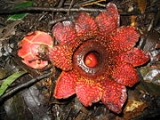
Sapria
Encyclopedia
Sapria is a genus
of parasitic flowering plant
s. It grows within roots of Vitis
and Tetrastigma
. The genus is limited to the tropical forests of South
and South-east Asia.
The flowers of Sapria are about 20 cm in diameter, bright red with yellow or white dots, unisexual and dioecious. In contrast with the related genus Rafflesia
the flowers have 10 lobes.
Three species are described, S. himalayana is found in Cambodia, parts of China, northeast India, Myanmar, Thailand and Vietnam, while S. poilanei is found in Cambodia and Thailand. The newly described third species S. ram is found in Thailand.
Genus
In biology, a genus is a low-level taxonomic rank used in the biological classification of living and fossil organisms, which is an example of definition by genus and differentia...
of parasitic flowering plant
Flowering plant
The flowering plants , also known as Angiospermae or Magnoliophyta, are the most diverse group of land plants. Angiosperms are seed-producing plants like the gymnosperms and can be distinguished from the gymnosperms by a series of synapomorphies...
s. It grows within roots of Vitis
Vitis
Vitis is a genus of about 60 species of vining plants in the flowering plant family Vitaceae. The genus is made up of species predominantly from the Northern hemisphere. It is economically important as the source of grapes, both for direct consumption of the fruit and for fermentation to produce...
and Tetrastigma
Tetrastigma
Tetrastigma is a genus of plants in the grape family, Vitaceae. The plants are vines that climb with tendrils and have palmately compound leaves. The species are found in subtropical and tropical regions of Asia, Malesia, and Australia, where they grow in primary rainforest, gallery forest and...
. The genus is limited to the tropical forests of South
South Asia
South Asia, also known as Southern Asia, is the southern region of the Asian continent, which comprises the sub-Himalayan countries and, for some authorities , also includes the adjoining countries to the west and the east...
and South-east Asia.
The flowers of Sapria are about 20 cm in diameter, bright red with yellow or white dots, unisexual and dioecious. In contrast with the related genus Rafflesia
Rafflesia
Rafflesia is a genus of parasitic flowering plants. It contains approximately 28 species , all found in southeastern Asia, on the Malay Peninsula, Borneo, Sumatra, Thailand and the Philippines.Rafflesia was found in the Indonesian rain forest by an Indonesian guide working for Dr...
the flowers have 10 lobes.
Three species are described, S. himalayana is found in Cambodia, parts of China, northeast India, Myanmar, Thailand and Vietnam, while S. poilanei is found in Cambodia and Thailand. The newly described third species S. ram is found in Thailand.

